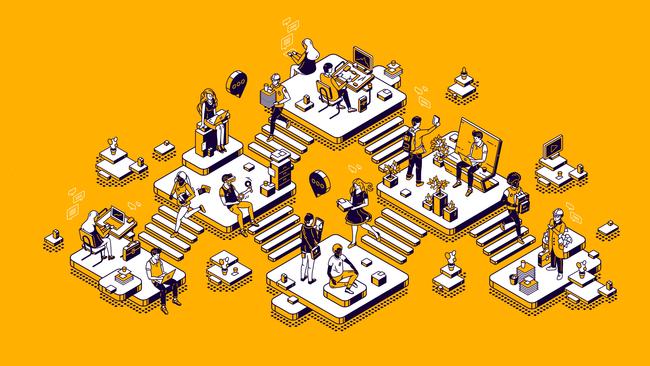Who will work from home after Covid-19?
Plenty of pundits are predicting the future of work. Economics correspondent Patrick Commins takes a look at the numbers.

We hear a lot about the potential for working from home becoming a permanent fixture, but is it realistic? What percentage of Australians can work from home? Which sectors do they come from?
In a speech to RMIT University in Melbourne this week, Productivity Commission chairman Michael Brennan offered a historical perspective. He noted how innovations such as steam and combustion engines made it easier and cheaper to truck workers into centralised locations, first big factories and then, increasingly, offices. And for all the talk of working from home among white-collar employers and workers before the pandemic, census data showed only 5 per cent of Aussies were actually doing so – a proportion that had remained unchanged for two decades.
Indeed, there has been little change to the working model since the industrial revolution, Brennan says, despite the internet revolution. Increasing congestion costs have created an environment ripe for change, he says. All that is needed is a catalyst.
“Just as industrial technology drove us physically together into the central workplace, could it be that modern communications technology is set to drive us apart?” he asks.
Not everyone working from home today will be working from home tomorrow once Covid-19 is in the rear-view mirror. The question is: how many?
Surveys suggest the pandemic permanently has disrupted the way many of us work. The Australian Bureau of Statistics special survey of businesses conducted during the health crisis showed that 40 per cent of employers said they had remote working arrangements in April – double the pre-pandemic rate. And almost 30 per cent of surveyed businesses said they intended to maintain remote working longer term.
Larger firms were most likely to support working from home, with the proportion doubling to well over 80 per cent by April, and about 70 per cent saying this was a permanent change.
The abandonment of cubicles for home offices during the pandemic is most clearly seen in office vacancy rates, which in Sydney and Melbourne have soared to about 15 per cent from below 5 per cent, according to the Reserve Bank.
Two academics from Deakin and Ghent universities have estimated that about 40 per cent of Australian jobs can be done from home – also the proportion of workers who reported they did so during the pandemic.
Full-time jobs are likelier to have the capacity for teleworking, at 41 per cent versus 35 per cent for part-time jobs, the academics estimated. Women are likelier to be able to work from home, at 46 per cent versus 33 per cent for men.
There will always be some work that can be done only in person: industries such as hospitality or construction have little scope to introduce remote working.
Nonetheless, the broadly high capacity and increased willingness to work from home suggest a sea change in Australians’ working habits.
The pandemic has revealed big socio-economic differences, both in location and incomes? What do the statistics tell us?
Recessions typically hit the most vulnerable hardest. Those with precarious employment are quick to lose the little work they have.
The Covid-19 downturn seemed to reinforce that template. In the initial stages of the health crisis, casual workers – often younger Australians – were laid off.
Women suffered the steepest drop in jobs and had to take on the bulk of home care duties. The employment prospects of the unemployed were reduced to virtually zero. But as the economy reopened through last year, the picture changed dramatically. Female employment came back stronger than before, while men lagged the labour market rebound – a reflection that the female-dominated health and caring professions were in even greater demand than before the health crisis.
Youth unemployment, too, dropped to below pandemic levels after spiking in the early stages of the Covid recession. And as the government ramped up support, the picture changed materially for many of the country’s disadvantaged.
The temporary doubling of the dole, for example, with the JobSeeker Covid supplement helped virtually eradicate poverty in this country, while JobKeeper kept Australians employed.
The Australian National University’s Ben Phillips estimates that the blow from shutting down large parts of the economy without counterbalancing support would have left more than one in 10 middle-class households below the poverty line, which is defined as a weekly disposable income of $416.
The health crisis triggered a 10 per cent permanent increase in the dole – not nearly as much as social welfare advocates and many economists had hoped, but a positive legacy nonetheless.
What’s the latest thinking on the productivity of those working from home?
The jury is very much out on whether workers can become more effective working from home.
Certainly the potential is for employees to take the opportunity to slack off when not directly under the gimlet eye of the boss.
Equally, though, the blurring of work and home can create an environment where we are never off the clock. Working more is not the same as being more productive, of course.
The Productivity Commission is expected to release a research paper by the middle of next month on working from home.
The head of the RBA’s economics department, Luci Ellis, has said the central bank’s business liaison program suggests the shift to working from home has been managed often with minimum disruption, while “a small number of firms even report that productivity rose” – not the most promising early report card.
Of course, productivity is just one facet of the working from home discussion. For city workers, regaining the hours spent schlepping in and out of the office can be a life-altering experience.
The opportunity to make a new life outside of the major urban centres is another plus, which offers a potential revitalisation of regional Australia. (Residents of small towns facing 20 per cent house price appreciation may disagree.)
When you speak to economists, what do they think the Australian workforce will look like after this? For example, fewer small and medium enterprise, consolidation, fewer workers, more digital?
Delivering an earnings update in April last year, Microsoft boss Satya Nadella marvelled at the incredible spike in customers using its Microsoft Teams virtual meetings product. “We’ve seen two years’ worth of digital transformation in two months,” he said.
It would be a familiar sentiment to many Australians forced to conduct their meetings virtually during the past 18 months. Australian businesses of all stripes have had to move quickly to incorporate digital processes into their business models. Whether it be the surge in online shopping, or the arrival of telehealth in a big way, the trend towards digitisation has moved from ponderous to lightning fast.
How well firms are able to take advantage of this development could well determine their ability to thrive in a post-pandemic world. Training Australians to make the most of this transformation will be key to success at an individual and national level.



